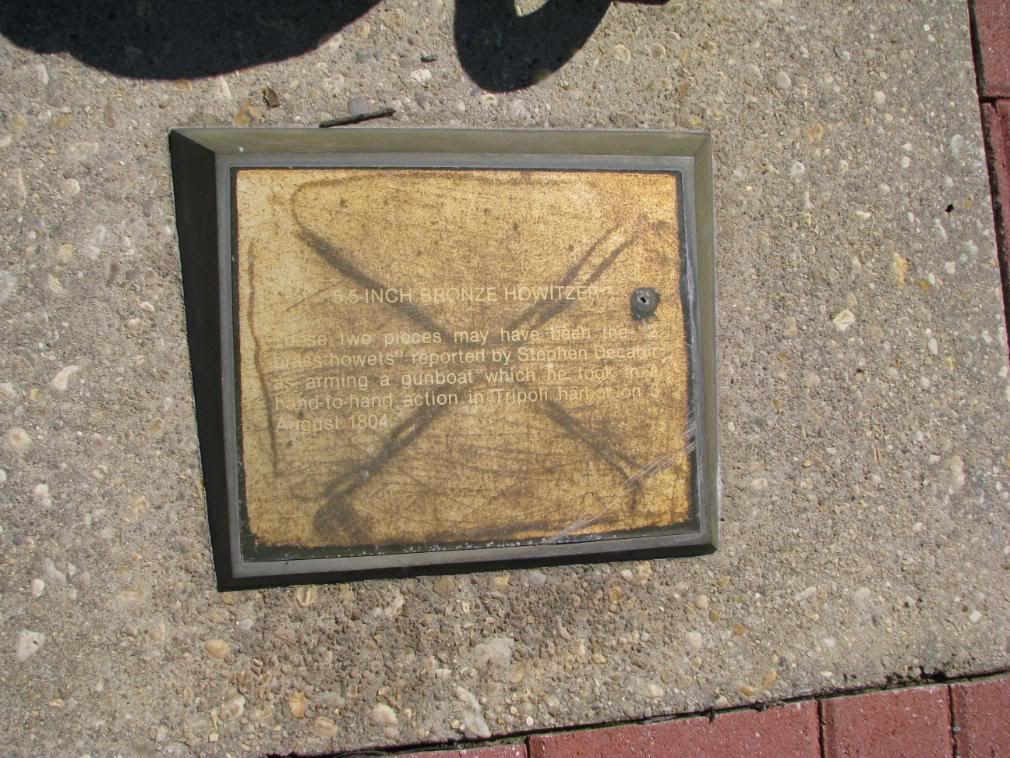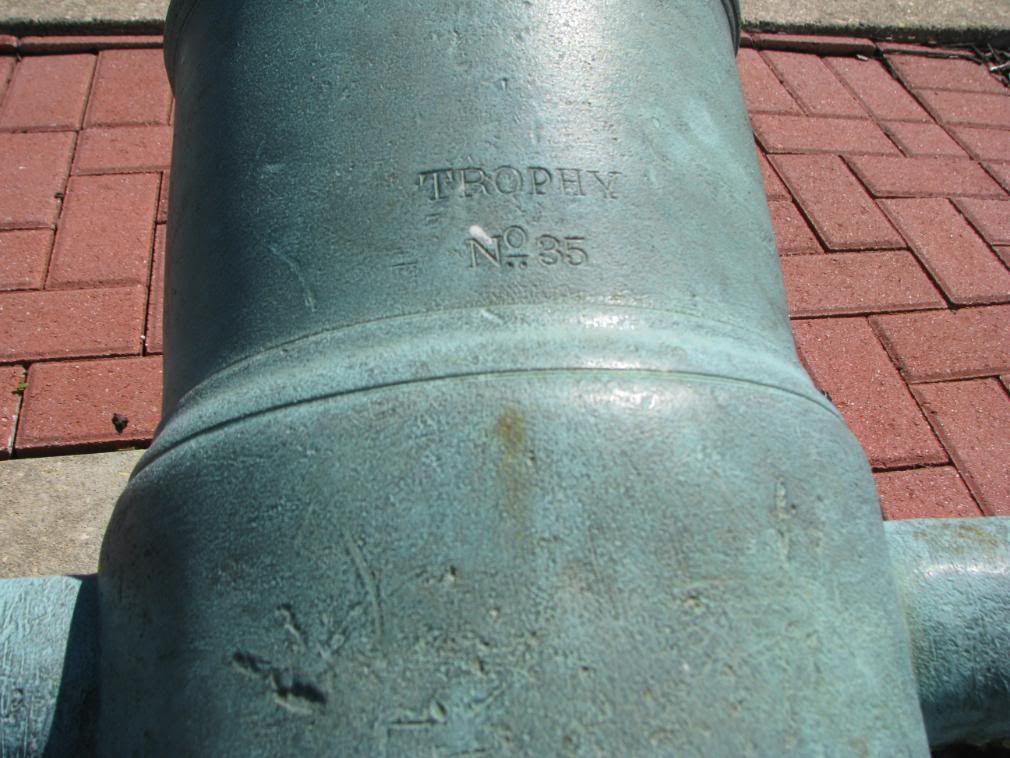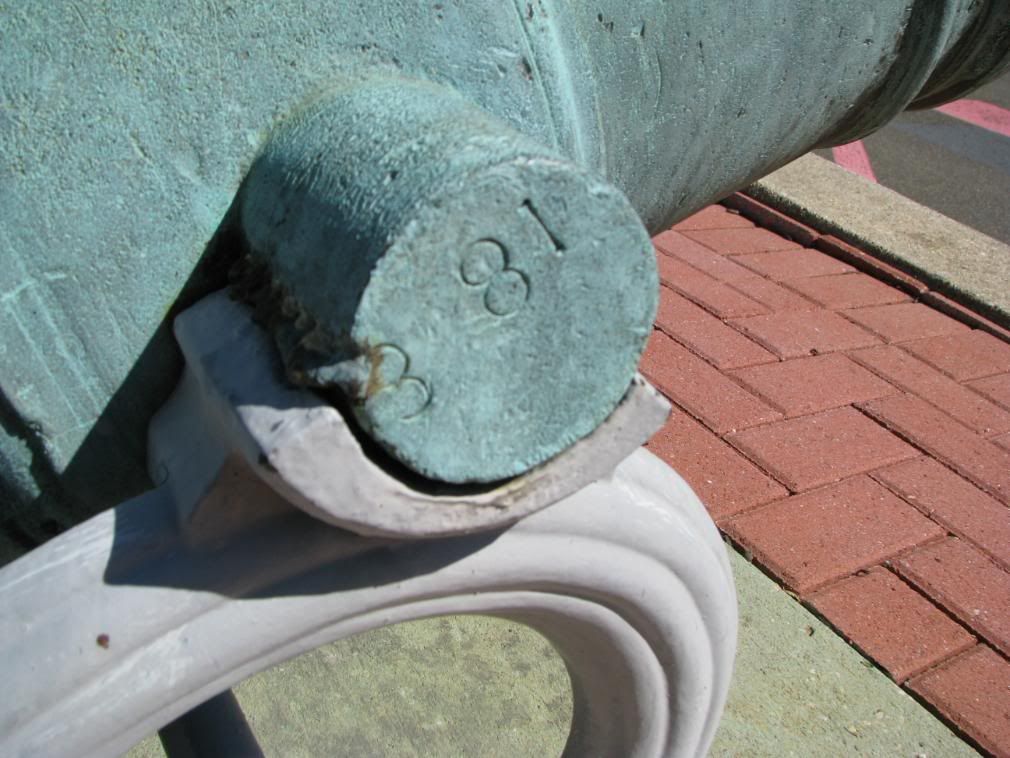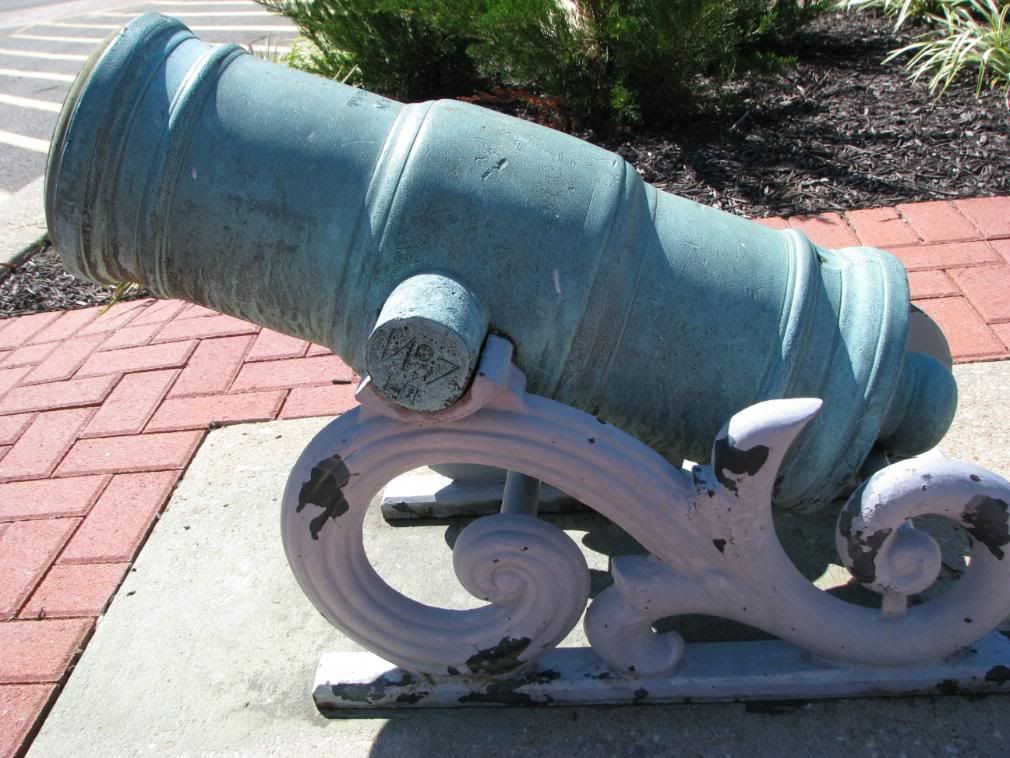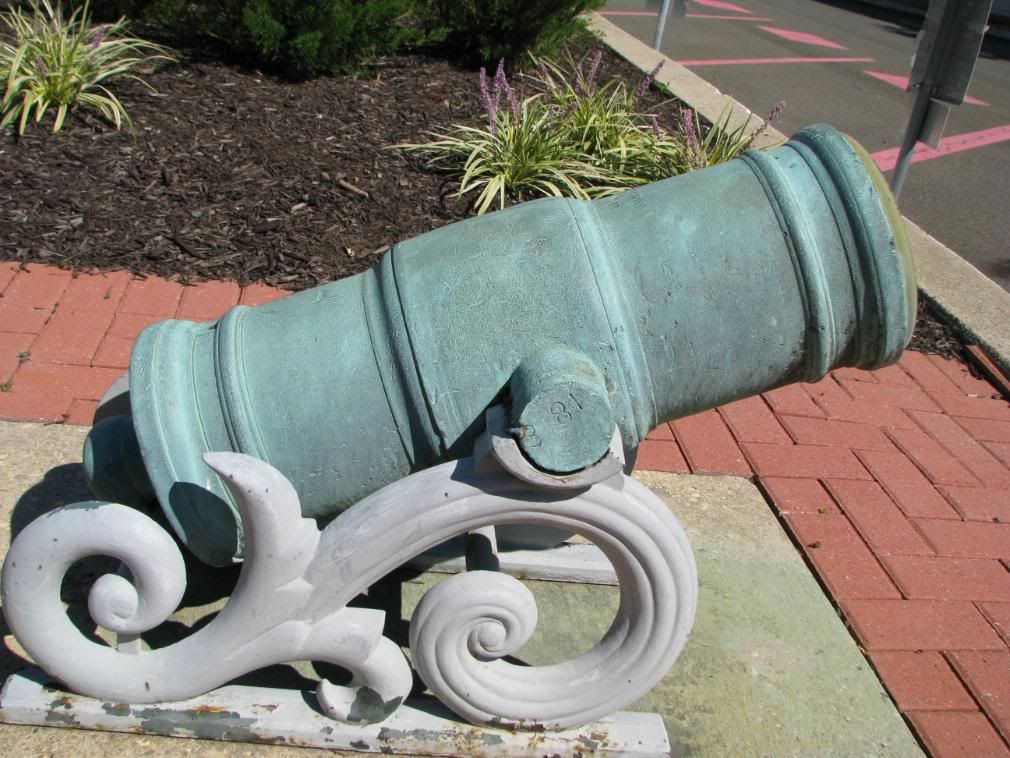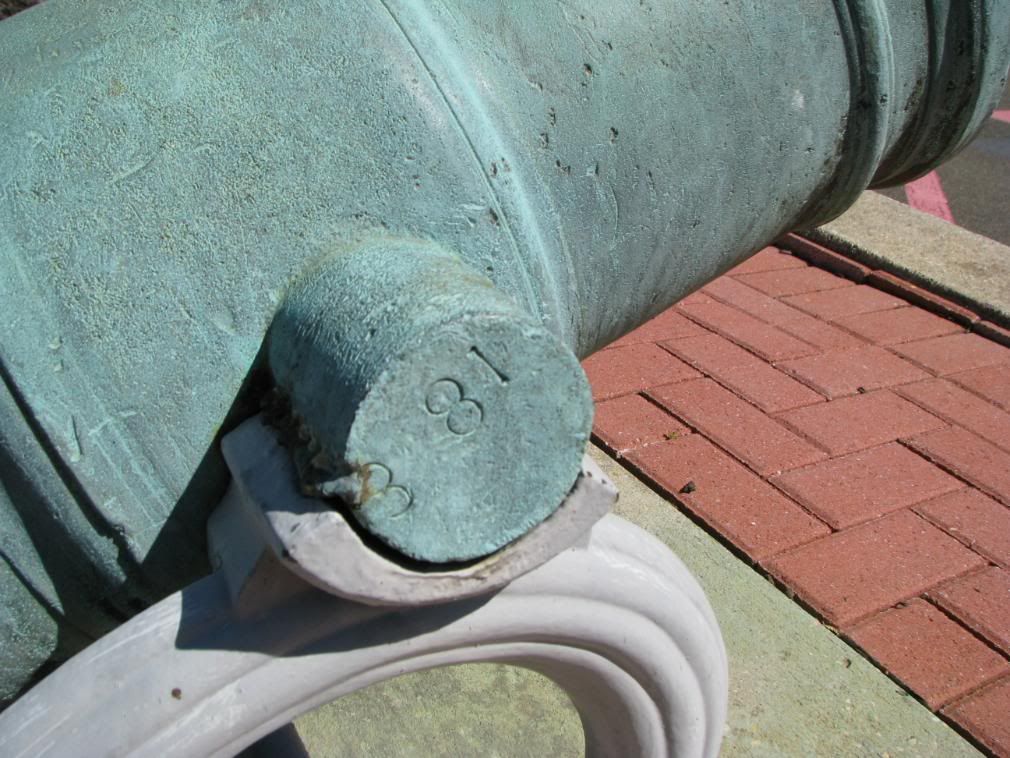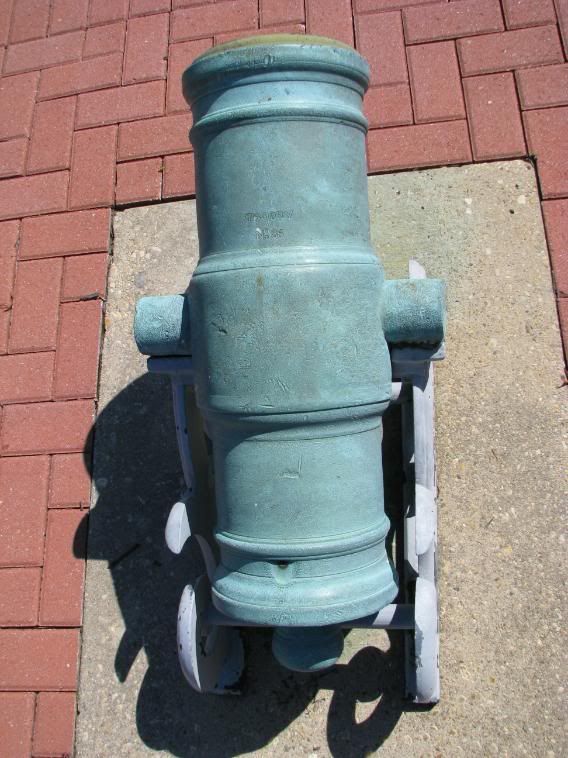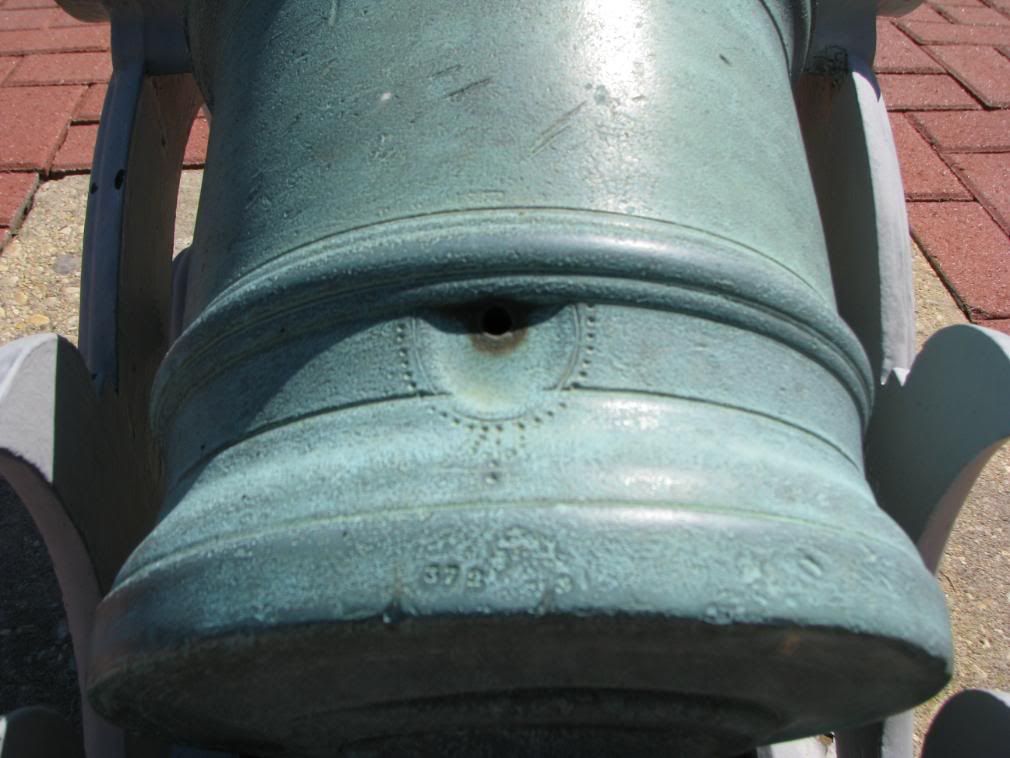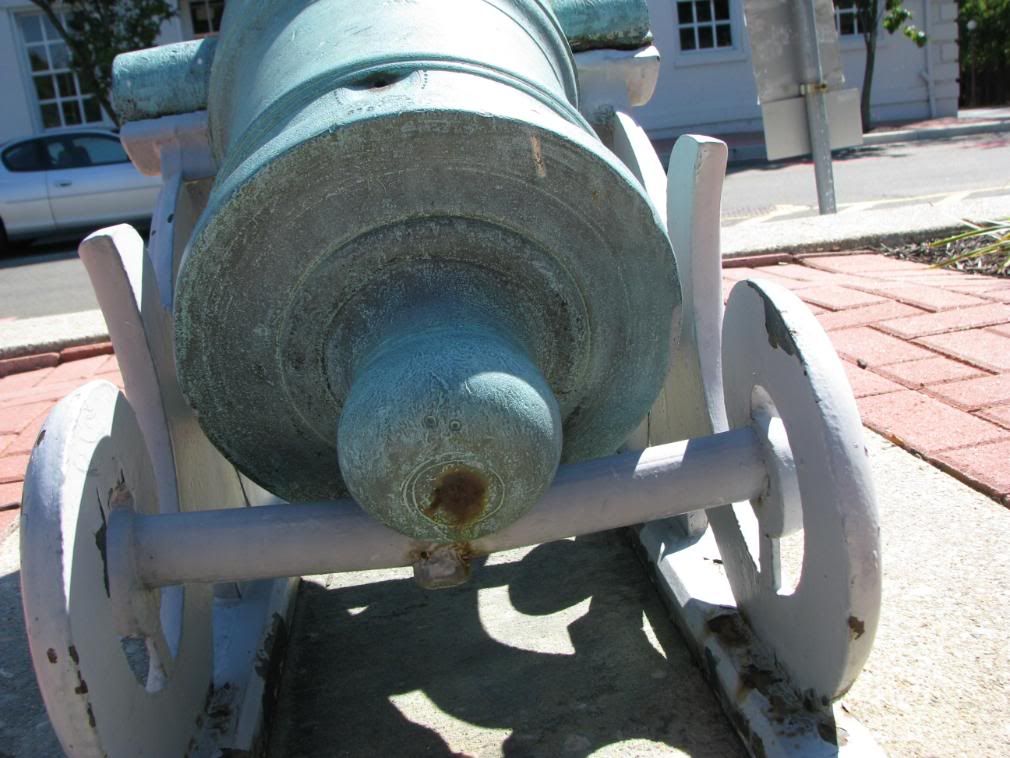A pair of unidentified bronze howitzers on display in Leutze Park at the Washington Navy Yard may have been used by the US in the Revolutionary War. The two howitzers are on the end of a row of four howitzers at the river end of Leutze Park. They are among the two-dozen or so priceless bronze trophies that have lain exposed to the elements for probably over 150 years.
The reason for this brief article is that recently I inspected and photographed a large number of bronze cannons at many east coast museums. When I examined the two howitzers in question, I recalled another nearly identical howitzer I had seen only a few weeks before at Watervliet Arsenal Museum. When I checked the photographs, I saw minor phyisical differences but basically the weapons were the same. One of the key traits that tied them together were their trunnion markings. The right trunnion had what was apparently a weight mark in the format "P XXX" in two lines, and the left trunnion had a rather unique marking format. This consists of a backwards capital letter "N" followed by lower case "o" obviously abbreviating "number" then a single digit. The Watervliet piece bears number "8" in that format, while the Washington Navy Yard piece (the one of the pair that has the trunnion so marked) bears the number "7." Further, beneath the number are stamped the letters "HT" which may be an abbreviation for "howitzer." I have also seen that abbreviation on the trunnions of early American bronze 8-inch howitzers at Fort Ticonderoga, NY.
As I've mentioned in previous posts, I've seen a number of early American bronze howtizers which have a curious piece of iron or steel embedded in the cascabel, extending all the way from the rear of the chamber to the rear end of the cascabel. I've speculated in previous posts that this could be a James Byers (of Philadelphia and later Springfield MA) signature casting characteristic, perhaps a casting core support similar to the european "cruzeta" or chaplet. Both of the Washington howitzers and the Watervliet howitzer have this interesting iron piece.
I had not measured the Watervliet howitzer during my last visit so I called Mr. Bob Pfeil, interim curator, for information which he graciously provided today. The information on the Watervliet howitzer, from my phone notes, included (From museum records): "US Army bronze 24 pounder howtizer, 1778." (date is not marked, so this is apparently an estimate.) Numbered on muzzle: "No. 83" (this is a later Army inventory number.) Number on breech "220" (I think this is yet another later inventory number.) Diameter 15 inches. Trunnions 2 3/4 inches (length or diameter?.) Bore located offcenter. Numberous air holes in casting. Bore diameter 5 5/8 inches. Length overall 31.5 in. Weight 400 lbs. Nominal length 26 1/8 inches (measured by Bob this morning.) One note I'll put here is that "24 pounder" is the 19th C. nomenclature for this size howitzer bore. In my opinion, "5.5 inch" is a more appropriate designation for this class of 18th C. field howitzer, and follows the contemporary British system.
Since the two Washington pieces appeared identical, I measured the one with the trunnion marked "No. 7" which bears a Navy-stamped inventory number "Trophy No. 35" so I could compare dimensions with the Watervliet piece. I only took a few key measurements, which seem to compare favorably with the Watervliet howitzer, although there are obvious differences which could be due to the accuracy of measurement, since I don't know who took the measurements at Watervliet nor when. The Navy Yard piece, as measured by myself a few days ago: Nominal length 26 1/8 inches, Bore 5.5 in., Trunnion diameter 3 in., length over trunnions 14.75 in., trunnion length 2.75 in., breech diameter 9.6 in., muzzle diameter 9.3 in., cascabel diameter 3.75 in. The tiny numerals "372" are stamped into the breech of this piece. The fact that this stamping is located where it is, and was obviously made with fairly modern metal stamps (from the appearance of the numeral style,) indicates to me this is probably the result of a weighing accomplished as a part of some long-forgotten inventory of the various trophies. It would be interesting to weigh the piece again and see how much metal it has lost due to corrosion since the "372" weight was stamped on it. Fortunately, for whatever reason, this particular piece has not suffered from corrosion nearly as much as some of its neighbors. We can safely assume the mark on the right trunnion "3 81" means the weight after finishing the piece was 381 lbs.. As of its subsequent weighing by the Navy showing 372 lbs., the howitzer had lost 9 lbs. of bronze. Some may have been scraped or burned out during firing, and some was probably lost due to corrosion.
There's at least one obvious physical difference between the nearly-identical Washington howitizers and the Watervliet example, in the vent area. The Washington pieces have a depressed vent pan, lined with decorative punch marks. Decorative punch marks are fairly rare, but I've seen them on two 6-pounder field guns believed to have been cast by James Byers for the State of New York. The Watervliet piece simply has a hole drilled in that location to serve as the vent.
The Navy's information on "trophy No. 35" is reflected in the text on the Naval Historical Center website. The website's numbering system does not utilize the cryptic Navy "trophy number" system and instead lists the pieces in the order they are encountered in a walking tour. From the website: "No. 21. This piece, as well as the five which follow, are typical howitzers used from the late 1600's into the early 1800's. Unlike their longer-barrelled mid-19th century descendants in this collection ...they are only about four calibers long. This howitzer and no. 22 are believed to be of British make, though neither bears any marking to confirm this. Naval Historical Center Artifact Catalog Number 61-84-AZ."
I can't speculate at this point on how the Navy acquired these early American howtizers as trophies of war. Perhaps they were captured from the US at some point, then re-captured later, as was the case with a few other bronze weapons displayed in Leutze park. I am fairly well convinced, however, that these pieces were cast for the U.S. by James Byers sometime during the late 18th C., and probably during the Revolutionary War. Further research should include examining the Navy's file cards on these weapons, and checking for any records on them that may be in the National Archives, particularly Record Group 74.
One reason I'm so concerned about the continued corrosion of the bronze guns in Leutze park is that some have already lost critical markings that unfortunately were never recorded nor photographed while they were still legible. The rest of the cannons are either slowly or rapidly losing what's left of their markings, the rate of loss depending on various undetermined factors such as perhaps the particular alloy composition of bronze used in that piece. You can see from the present investigation how critical some of the cryptic markings, such as those on the ends of the trunnions, can be. Some museum staff people may not know what those markings represent, and might tend to ignore them if and when they do get around to recording the cannon markings.
Images of the Washington Navy Yard howitzer (Watervliet specimen photos will be in a subsequent posting)
